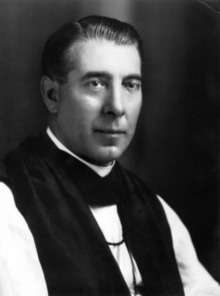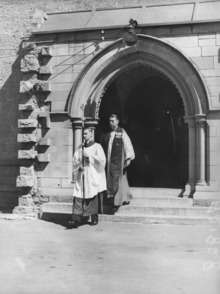William Wand
John William Charles Wand, KCVO, PC (25 January 1885 – 16 August 1977) was an English Anglican bishop. He was the Archbishop of Brisbane in Australia before returning to England to become the Bishop of Bath and Wells before becoming the Bishop of London.
William Wand KCVO PC | |
|---|---|
| Bishop of London | |
 Wand as Archbishop of Brisbane | |
| Church | Church of England |
| Province | Province of Canterbury |
| Diocese | Diocese of London |
| In office | 1945–1955 |
| Predecessor | Geoffrey Fisher |
| Successor | Henry Montgomery Campbell |
| Other posts | Bishop of Bath and Wells (1943–1945) Archbishop of Brisbane (1934–1943) |
| Orders | |
| Ordination | 1908 (deacon) 1909 (priest) |
| Consecration | 1 May 1934 |
| Personal details | |
| Birth name | John William Charles Wand |
| Born | 25 January 1885 |
| Died | 16 August 1977 (aged 92) |
| Nationality | English |
| Denomination | Anglicanism |
| Spouse | Amy Agnes Wiggins b.1883
( m. 1911; died 1966) |
| Education | The King's School, Grantham |
| Alma mater | St Edmund Hall, Oxford Bishop Jacob Hostel |
Early life
William Wand was born in Grantham, Lincolnshire, the son of Arthur James Henry Wand, a butcher, and his wife Elizabeth Ann Ovelin, née Turner. Despite Wand's father being a staunch Calvinist, his mother brought him up in the Church of England. Educated at The King's School, Grantham and St Edmund Hall, Oxford, where he took first-class honours in theology (BA, 1907; MA, 1911), he prepared for ordination at Bishop Jacob Hostel, Newcastle upon Tyne and was ordained a deacon in 1908 and a priest in 1909. He served curacies at Benwell and Lancaster. On 11 October 1911 he married Amy Agnes Wiggins (1883-1966) at St Leonard's parish church in Watlington, Oxfordshire.
World War I

Wand was appointed vicar-choral of the Diocese of Salisbury in 1914. On the outbreak World War I he enlisted as a military chaplain and reached Gallipoli in July 1915. He was a chaplain to the 2nd Australian Hospital and, after being invalided home with paratyphoid fever, served in France.
Demobilised in March 1919, Wand was made perpetual curate of St Mark's, Salisbury, where St Clair Donaldson was bishop. In 1925 Wand became a fellow and the dean of Oriel College, Oxford and university lecturer in church history. Eight years later Bishop St Clair Donaldson was asked by Archbishop Lang to nominate a candidate for the see of Brisbane as archbishop. Wand was consecrated in St Paul's Cathedral, London, on 1 May 1934 and enthroned in St John's Cathedral, Brisbane on 5 September.
Wand's arrival in Queensland was almost immediately clouded by the death in a climbing accident, near Chamonix-Mont-Blanc on France/Switzerland border, of his only son, Paul (1912–34). He had a difficult reception: those who had wanted a local dignitary as their new bishop united to oppose Wand. His attempts to eradicate slackness made him appear authoritarian to his clergy. Sturdy in appearance, shy and gracious, Wand was often seen as being aloof and something of an intellectual snob though this belied his natural humour and quick wit. The decision to move St Francis's Theological College from Nundah to the Bishopsbourne property was unpopular, although Wand's relations with its students won him their respect and affection and its proximity to the Archbishop's home improved the standards of training. His establishment of a property and finance board to handle the economic problems of the diocese also did not meet with general favour.
As a member of the University of Queensland senate, Wand worked to promote biblical studies and helped to create the first university theological faculty in Australia. During his episcopate he wrote a weekly article for The Courier-Mail, translated the New Testament epistles and gave the Moorhouse lectures in Melbourne in 1936.
World War II
He consecrated the cathedral of St Peter and St Paul, Dogura, New Guinea on 29 October 1939. The date was continually altered owing to the start of World War II and its isolated position. Dogura is in Milne Bay Province.[1] The cathedral was built on a battle site, held 800 with a further 500 standing outside at the consecration.[2]
Wand made a lecture tour of the United States of America in 1940. He argued in support of a new constitution for the Church, but thought that the proposed appellate tribunal should have a majority of bishops, rather than legal laymen, to determine points of doctrine.
During World War II, when Brisbane resembled a garrison town, Wand and his wife worked for the Soldiers, Sailors and Airmen's Help Society. His 1942 address to the Royal Society of St George defended the British war effort and was published as the pamphlet, "Has Britain Let Us Down?" It prompted questions in the Federal parliament and attracted the attention of such British politicians as Viscount Brendan Bracken and Winston Churchill. Early in 1943 Wand was surprised to be offered the See of Bath and Wells. He left Brisbane in July. Two years later he was translated to London.
Post-war
In London post-war difficulties, including the rebuilding of shattered city churches, challenged and revealed Wand's administrative gifts. As bishop, Wand was a privy counsellor; in 1955 he was appointed KCVO;[N 1] in 1946-57 he was prelate of the Order of the British Empire. After resigning his see in 1956, he was appointed minor canon and later Canon Treasurer of St Paul's Cathedral, London, until 1969 and edited The Church Quarterly Review.[3] A wide-ranging and facile historian, he wrote forty-five books, among them a History of the Modern Church (1930), History of the Early Church (1937), White of Carpentaria (1949), Anglicanism in History and Today (1961) and an autobiography, The Changeful Page (1965). Survived by a daughter, Wand died on 16 August 1977 at the College of St Barnabas, Lingfield, Surrey, and was cremated. An obituary in the Church Times paid tribute to his scholarship, administrative genius and unsentimental piety.
With the Bishop of Fulham Basil Batty, he supported the early ecumenical movement. He was the first Chairman of the Executive body of the British Council of Churches, attending the 1948 foundation of the World Council of Churches in Amsterdam.[4]
Seretse Khama affair
On 25 September 1948, Seretse Khama, a 27-year-old black African man, and Ruth Williams, a 24-year-old white English woman, went to the Anglican St George's Church in Campden Hill, London, to get married. Half an hour before the service their vicar, the Reverend Leonard Patterson, under severe pressure from various parties opposed to the inter-racial marriage, told the couple he was not willing to perform at the ceremony.[5]
Khama, who was heir to the kingship of the British protectorate of Bechuanaland, and Williams, who was a London insurance clerk, pleaded with Patterson to change his mind, but instead he took them to the nearby St Mary Abbots church in Kensington to meet Wand, who, as Bishop of London, was performing an ordination. There they attempted to gain Wand's consent to be married in the Church of England. However, Wand refused such permission without even speaking to the couple himself, sending the Archdeacon of Middlesex with a message that read: "Get in touch with the Colonial Office. When they agree to the wedding, I will".[5]:23–24
Although senior officials at the Colonial Office had no say over whether the couple could get married in a church, or indeed anywhere else, they had made it known through various back channels that they were opposed to the union, not only because they found it distasteful but because they believed that, given Khama's royal status, it would create political difficulties with apartheid South Africa, a neighbouring state to Bechuanaland.[5]
Wand's refusal to sanction a church ceremony forced Khama and Williams to get married in a civil service four days later, at Kensington Registry Office in London.[5]
Selected works
- A History of the Modern Church from 1500 to the Present Day, 1930.
- A History of the Early Church to A.D. 500, Methuen, 1937.
- The Authority of the Scriptures, Mowbray, 1949.
- Seven Steps to Heaven, Longman, Green & Co. Ltd, 1956.
- The Church Today: A brief description of the Christian Church in its external variety and its inner unity, Penguin, 1968.
Notes
- Despite being a knight, the tradition in Britain is that no cleric bears the title of "Sir".
References
- Dogura Cathedral. Retrieved 13 February 2011.
- http://anglicanhistory.org/aus/png/dogura_consecration1939.html
- Arnott, F.R. "Wand, John William Charles (1885 - 1977)". Australian Dictionary of Biography. Retrieved 5 July 2010.
- Peart-Binns, John S. Wand of London. (Oxford, Mowbray, 1987)
- Williams, A. Susan (2016). Colour bar : the triumph of Seretse Khama and his nation. Penguin Books. ISBN 978-0-14-198570-1.
- F. R. Arnott, 'Wand, John William Charles (1885 - 1977)', Australian Dictionary of Biography, Vol. 12, MUP, 1990, p. 377. Retrieved 19 January 2010
External links
| Church of England titles | ||
|---|---|---|
| Preceded by Gerald Sharp |
Archbishop of Brisbane 1934–1943 |
Succeeded by Sir Reginald Halse |
| Preceded by Francis Underhill |
Bishop of Bath and Wells 1943–1945 |
Succeeded by Harold Bradfield |
| Preceded by Geoffrey Fisher |
Bishop of London 1945–1955 |
Succeeded by Henry Montgomery Campbell |